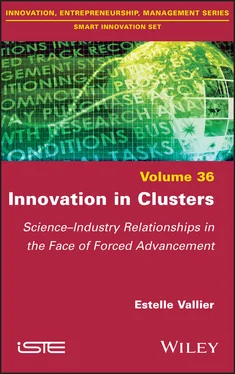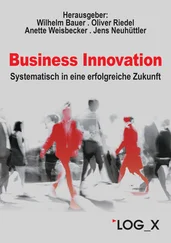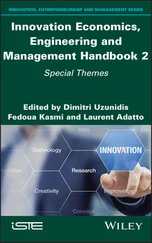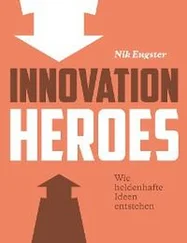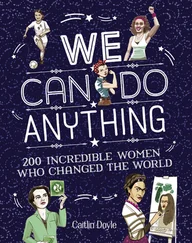1 Cover
2 Title Page Smart Innovation Set coordinated by Dimitri Uzunidis Volume 36
3 Copyright First published 2021 in Great Britain and the United States by ISTE Ltd and John Wiley & Sons, Inc. Apart from any fair dealing for the purposes of research or private study, or criticism or review, as permitted under the Copyright, Designs and Patents Act 1988, this publication may only be reproduced, stored or transmitted, in any form or by any means, with the prior permission in writing of the publishers, or in the case of reprographic reproduction in accordance with the terms and licenses issued by the CLA. Enquiries concerning reproduction outside these terms should be sent to the publishers at the undermentioned address: ISTE Ltd 27-37 St George’s Road London SW19 4EU UK www.iste.co.uk John Wiley & Sons, Inc. 111 River Street Hoboken, NJ 07030 USA www.wiley.com © ISTE Ltd 2021 The rights of Estelle Vallier to be identified as the author of this work have been asserted by her in accordance with the Copyright, Designs and Patents Act 1988. Library of Congress Control Number: 2021943916 British Library Cataloguing-in-Publication Data A CIP record for this book is available from the British Library ISBN 978-1-78630-625-8
4 Foreword
5 Introduction
I.1. Innovation policies and the clustering process I.1. Innovation policies and the clustering process In France, innovation clusters are the result of a legislative and fiscal framework that has encouraged closer ties between science and industry for more than 30 years. In this context, the state, as well as international and European authorities, is particularly encouraging territories to develop clustering policies. However, this logic is not a new idea and has been the subject of work since the 19th century, under other names. The term cluster, on the other hand, was conceptualized in North American management literature in the 1990s and has found favor in most public policies in industrialized countries.
I.2. The cooperation mechanism in a biocluster context: from concept to reality I.2. The cooperation mechanism in a biocluster context: from concept to reality Originating in the United States, the cluster concept has become a worldwide phenomenon. In France, it has been supported by public authorities through the creation of intermediation structures in charge of strengthening the relationship between science and industry.
I.3. Acknowledgements
6 PART 1 Persistence and Renewal of the Cluster Concept in Contemporary Innovation Policies 1 From Industrial Districts to Knowledge Valleys: the Legacy of the Cluster 1.1. The industrial district: the oldest ancestor of the cluster 1.2. Spatial concentrations of technological activities 1.3. The valleys of knowledge: interindividual relations as a source of innovation 2 The Management Roots of the Cluster and Its Worldwide Dissemination 2.1. An economic and management concept destined to become a public action mechanism 2.2. Global dissemination of good clustering practices 2.3. The French legislative framework from the 1980s to the 2010s: a favored coming together of science and industry 3 The Cluster Imaginary: Tools, Local Narrative and Promise 3.1. Performative instruments: benchmarking, territorial marketing, visual instrumentation 3.2. The construction of a narrative 3.3. Promises of innovation and employment at the territorial level
7 PART 2 Prevented Synergies: the Case of a Biotechnology Cluster 4 Networking Systems: Repeated but Hindered Initiatives 4.1. Scientific and industrial administration: establishing a recurrent event 4.2. Sharing a technology platform: mutualization or collaboration? 4.3. The institutionalization of conviviality: “ la vie de site ” 5 Scientific Competition and Economic Competition: Social Fields Spanned by Internal Struggles 5.1. Asynchronous organizations and work rhythms 5.2. A scientific field built from struggle and precarity 5.3. An unstable relationship between economic development and industrial secrets for companies 6 The Avoided Cooperation 6.1. A patchy local network 6.2. Cooperation prevented by paradoxical demands 6.3. Avoidance strategies
8 Conclusion
9 References
10 Index
11 End User License Agreement
1 Chapter 1Figure 3.1. Changes in square footage dedicated to research structures in the Un...
2 Chapter 4Figure 4.1. Cluster workers’ participation in professional events (source: graph...Figure 4.2. Type of platform usage by users (source: graph constructed from ques...Figure 4.3. Institutional affiliation of the 2016 Platform Day participants (sou...
3 Chapter 5Figure 5.1. Age of company directors (source: graph constructed from the Genopol...
4 Chapter 6Figure 6.1. Network between 42 biocluster structures 5. For a color version of th...Figure 6.2. Intra- and extra-cluster organizational relationships (in France and...
1 Introduction Table I.1. Summary of data collected
2 Chapter 6Table 6.1. Typology of network structuresTable 6.2. Typology of cluster interactions
1 Cover
2 Table of Contents
3 Title Page Smart Innovation Set coordinated by Dimitri Uzunidis Volume 36
4 Copyright First published 2021 in Great Britain and the United States by ISTE Ltd and John Wiley & Sons, Inc. Apart from any fair dealing for the purposes of research or private study, or criticism or review, as permitted under the Copyright, Designs and Patents Act 1988, this publication may only be reproduced, stored or transmitted, in any form or by any means, with the prior permission in writing of the publishers, or in the case of reprographic reproduction in accordance with the terms and licenses issued by the CLA. Enquiries concerning reproduction outside these terms should be sent to the publishers at the undermentioned address: ISTE Ltd 27-37 St George’s Road London SW19 4EU UK www.iste.co.uk John Wiley & Sons, Inc. 111 River Street Hoboken, NJ 07030 USA www.wiley.com © ISTE Ltd 2021 The rights of Estelle Vallier to be identified as the author of this work have been asserted by her in accordance with the Copyright, Designs and Patents Act 1988. Library of Congress Control Number: 2021943916 British Library Cataloguing-in-Publication Data A CIP record for this book is available from the British Library ISBN 978-1-78630-625-8
5 Foreword
6 Introduction
7 Begin Reading
8 Conclusion
9 References
10 Index
11 End User License Agreement
1 v
2 iii
3 iv
4 ix
5 x
6 xi
7 xii
8 xiii
9 xiv
10 xv
11 xvi
12 xvii
13 xviii
14 xix
15 xx
16 xxi
17 xxii
18 xxiii
19 xxiv
20 xxv
21 xxvi
22 xxvii
23 1
24 3
25 4
26 5
27 6
28 7
29 8
30 9
31 10
32 11
33 12
34 13
35 14
36 15
37 16
38 17
39 18
40 19
41 20
42 21
43 22
44 23
45 25
46 26
47 27
48 28
49 29
50 30
51 31
52 32
53 33
54 34
55 35
56 36
57 37
58 38
59 39
60 40
61 41
62 42
63 43
64 44
65 45
66 46
67 47
68 48
69 49
70 50
71 51
72 52
73 53
74 54
75 55
76 56
77 57
78 58
79 59
80 60
81 61
82 62
83 63
84 64
85 65
86 66
87 67
88 68
89 69
Читать дальше
